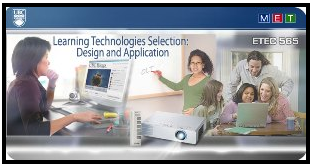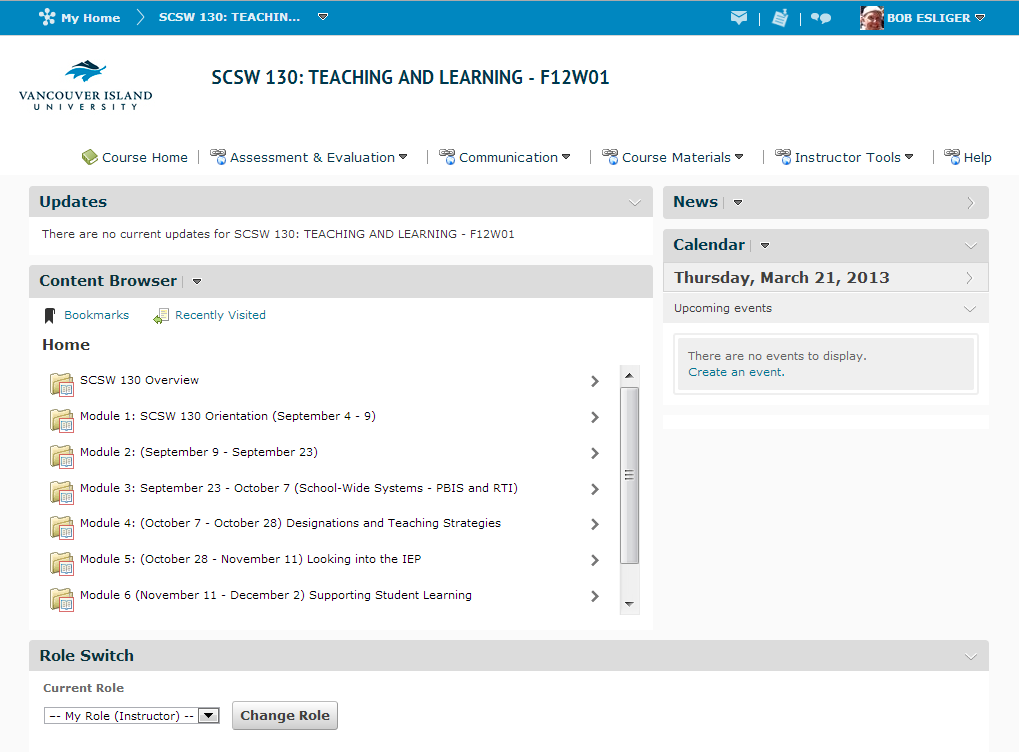Just as the early pioneers had to learn quickly and construct knowledge from prior learning experiences, I also had to jump in quickly and learn as I went along. The reason for this is that as this course began I also accepted a sessional position to teach a blended course at the local university. This is exactly what I wanted to learn how to do and the timing couldn’t have been better!
 ETEC 565A – Learning Technologies: Selection, Design and Application
ETEC 565A – Learning Technologies: Selection, Design and Application
This course was an online seminar that provided several theoretical frameworks to assist in evaluating, selecting and using various learning technologies. I gained hands-on experience using a range of learning technologies and platforms: web-publication, course management systems, communication tools, community and collaboration tools, multimedia, and social software tools. Through this course I gained a working knowledge of a number of different learning technologies as well as completed a large project in which I incorporated several technologies together in order to design materials and activities to support student learning.
Artifacts
Written Artifact 1: Delivery Platform Evaluation Rubric
Written Artifact 2: LMS Proposal
 Technology Artifact 3: As mentioned in the introduction to this course, part of the learning was to create an online course. I had accepted the position to teach this course as I was taking this ETEC 565a course and it was an incredible learning experience.
Technology Artifact 3: As mentioned in the introduction to this course, part of the learning was to create an online course. I had accepted the position to teach this course as I was taking this ETEC 565a course and it was an incredible learning experience.
This course was initially created in Moodle and I had learned in ETEC 510 how to do some amazingly creative things in that LMS, but the university was in the transition over to D2L and asked if I would be part of the pilot – so I agreed. I had never used D2L (nor had I heard of it) and I was excited to learn a new LMS. So off I went, learning along the way.
Please have a look at this short video clip of the LMS that I created.
Insert video clip here. XXX
Technology Artifact 4: A Digital Story about Inclusion
General Reflection:
In my LMS proposal I determined that Moodle was the way to go because it is a very flexible and cost effective LMS. It is easy to navigate, has features that are directly applicable to the classroom, addresses student diversity and it is easily customizable. Moodle’s philosophical and pedagogical foundations are conducive to classroom practices which would allow it to fit seamlessly into any teacher’s repertoire. Furthermore, Moodle has a strong online support community and documentation to help the district/individuals get started and work out problems that may occur.
What sets Moodle apart from other potential open source LMS systems is that it is specifically designed with teachers in mind, allowing for easy course development and maintenance.
Now that I have experienced D2L (Desire to Learn) I have come to understand that no two LMS are created equal. There are various components that I like about each one of them. D2L provides the next an interactive learning environment including components that engage and inspire lifelong learners. D2L actually assist in adult learning by breaking down barriers to access quality learning experiences. D2L is also recognized for its leadership in accessibility as a global leader in cloud (SaaS) based learning solutions.
Reflecting toward the future:
What do I see as the supports that would help me to further cultivate my practice of pioneering leadership?
- I feel that I have used the “general” components of the D2L system and have created an interactive and comprehensive course.
- The part that I want to further cultivate is the online video-conferencing component so that i can hold lectures online and have work directly with students in a real-time, synchronous manner.
- Webinar is the online platform that I’d like to learn more about in terms of delivering f2f video conferences with students.
How does theory learned in this course offer me insights about how I might nurture a change in the culture of my community?
- As stated earlier in this eP, my biggest hope is that I will be able to create staff modules for use in my school district. These modules would initially be for new hires and would provide them with a thorough induction to the school district, process and procedures and relevant guidelines.
- The next step would be to create our universal Tier 1 inservice through a blended delivery of online and f2f methodologies.
Implementation, surprises, and consequences? Regrets?
- I didn’t expect there to be so many technology problems with D2L as I had experienced in the pilot group. Please remember that I joined the pilot group never having heard of D2L before. I created the course one module ahead of my students, as we went along. I created many discussion forms which I will have to re-think because the monitoring too far too much of my time.
- The glitches in the platform often appeared to my students that I didn’t know what I was doing – but we persevered. I would explain that something was a glitch and it was being worked on but the students were less savvy than I was so their first reaction was to direct their frustration at me.
- No regrets. I learned a great deal!
How does this project affect your practice or what new perspectives have you discovered in reflection?
- Well, I would sign-up for a pilot group to test a new LMS in a heartbeat as I found it to be a truly rewarding experience.
- I look forward to learning about Webinar and how it can be dove-tailed with D2L to create one comprehensive package.
Next Steps:
- I am not teaching at the moment but I am slotted to teach a blended course this summer (July 2013) and a fully online course in September 2013.
- My next steps are to complete this eP and spend the next few months perfecting the course modules that I will be delivering and learning more about Webinar.
| Pioneer Trail | ||||
| Bullet Trail |